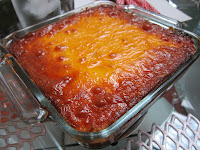Saturday Night: Quipes and Locrio de Pollo
 |
| Quipes |
Quipes reflect the influence of Middle Eastern immigrants as they are basically traditional kibbeh updated with the ingredients and spices more commonly found in the Dominican Republic. Whereas kibbeh generally consist of ground lamb and bulgur wheat seasoned with onion, mint, cinnamon, allspice, and cumin, I found most recipes for Dominican quipes used ground beef, instead of lamb, and included raisins in the filling. For the most part, quipe recipes included either basil or cilantro, instead of mint. The recipe I used also included tomato paste in the filling. The only issue with this dish was my poor chopping skills as the onion and red bell pepper should have been chopped much more finely. Nonetheless, the final product was delicious.
 |
| Locrio de Pollo |
Sunday Night Feast: Yucca Fritters, Pescado con Coco, Pernil, Pastelon de Platanos Maduros, Majarete, and Habichuelas con Dulce
On Sunday night, we didn’t hold back anything! Five food-loving, giddy people sharing some incredible dishes made for a night to remember. Honestly, I didn’t think we could eat it all, but we came very close. Every dish on the table sparked a new conversation, and none disappointed.
 |
| Yucca Fritters Photo by Stephanie Glass |
For starters, Carlos filled my cast iron skillet with some vegetable oil and fried the most delicious Yucca Fritters I have ever tasted. I fell in love with yucca when I moved to Miami, and his fritters now serve as top billing on my list of best yucca dishes. Just as he learned from his grandmother, he made the fritters with grated yucca, milk, eggs, and aniseed. That’s right, aniseed. What a brilliant addition to a simple dish!
 |
| Pecado con Coco Photo by Stephanie Glass |
 |
| Pernil Photo by Stephanie Glass |
 |
| Pastelon de Platanos Maduros Photo by Stephanie Glass |
 |
| Majarete and Habichuelas con Dulce |
All in all, I really enjoyed the Dominican Republic dishes this week, and I am so grateful to Carlos for his participation. My only regret is that I never made Mangu. Sometimes, life happens, and I just can’t seem to make everything I plan, but I have the queso de freir and salami waiting in my refrigerator for one morning this weekend. Hopefully, it will happen then. In the meantime, I definitely have to buy more green plantains, because I’ve waited so long that the ones I purchased are ripe now. That’s okay though. It just gives me another reason to look forward to the weekend.
I have to say, I knew very little about the cuisine of the Dominican Republic before, but it is delicious!
ReplyDelete